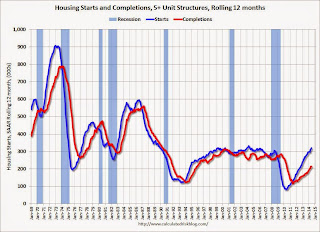by Calculated Risk on 7/17/2014 01:32:00 PM
Thursday, July 17, 2014
A few comments on June Housing Starts
This was a weak report for housing starts in June.
There were 479 thousand total housing starts during the first half of 2014 (not seasonally adjusted, NSA), up 6.0% from the 452 thousand during the same period of 2013. Single family starts are up 1%, and multi-family starts up 18%. The key weakness is in single family starts.
The weak growth so far in 2014 is due to several factors: severe weather early in the year, higher mortgage rates (although rates are now down year-over-year), higher prices and probably supply constraints in some areas. And some judicial foreclosure states are still working through a backlog of distressed homes that depress new construction.
Starts were up 7.5% year-over-year in June, but the year-over-year comparison for housing starts is easier now than in Q1 (see first graph). There was a huge surge in housing starts early in 2013, and then a lull - and finally more starts at the end of the year.
 Click on graph for larger image.
Click on graph for larger image.
This graph shows the month to month comparison between 2013 (blue) and 2014 (red).
Starts in Q1 averaged 925 thousand SAAR, and starts in Q2 averaged 980 thousand SAAR (up 6% from Q1).
This year, I expect starts to increase (Q1 will probably be the weakest quarter, and Q2 the second weakest).
Below is an update to the graph comparing multi-family starts and completions. Since it usually takes over a year on average to complete a multi-family project, there is a lag between multi-family starts and completions. Completions are important because that is new supply added to the market, and starts are important because that is future new supply (units under construction is also important for employment).
These graphs use a 12 month rolling total for NSA starts and completions.
 The blue line is for multifamily starts and the red line is for multifamily completions.
The blue line is for multifamily starts and the red line is for multifamily completions.
The rolling 12 month total for starts (blue line) has been increasing steadily, and completions (red line) are lagging behind - but completions will continue to follow starts up (completions lag starts by about 12 months).
This means there will be an increase in multi-family completions in 2014 and 2015. Multi-family starts will probably move more sideways soon.
 The second graph shows single family starts and completions. It usually only takes about 6 months between starting a single family home and completion - so the lines are much closer. The blue line is for single family starts and the red line is for single family completions.
The second graph shows single family starts and completions. It usually only takes about 6 months between starting a single family home and completion - so the lines are much closer. The blue line is for single family starts and the red line is for single family completions.
Single family starts had been moving up, but recently starts have been moving sideways on a rolling 12 months basis.
Note the exceptionally low level of single family starts and completions. The "wide bottom" was what I was forecasting several years ago, and now I expect several years of increasing single family starts and completions.


